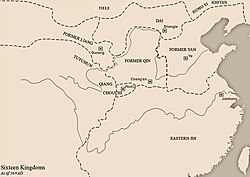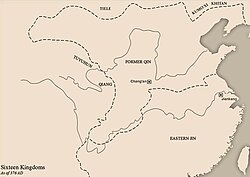Qin 秦 | |
|---|---|
| 351–394 | |
 Former Qin 369 CE | |
 Former Qin 376 CE | |
| Capital | Chang'an (351–385) Jinyang (385–386) Nan'an (386–394) Huangzhong (394) |
| Government | Monarchy |
| Emperor | |
• 351–355 | Fu Jiàn |
• 355–357 | Fu Sheng |
• 357–385 | Fu Jiān |
• 385–386 | Fu Pi |
• 386–394 | Fu Deng |
• 394 | Fu Chong |
| History | |
• Fu Jiàn's entry into Chang'an | 350 |
• Established | 4 March[1][2] 351 |
• Fu Jiàn's claim of imperial title | 352 |
• Fu Jiān's destruction of Former Yan | 370 |
| 383 | |
• Fu Jiān's death | 16 October 385[1][3] |
• Disestablished | 394 |
• Fu Hong's death | 405 |
| Today part of | China |
| Former Qin | |||||||
|---|---|---|---|---|---|---|---|
| Chinese | 前秦 | ||||||
| |||||||
Qin, known as the Former Qin and Fu Qin (苻秦) in historiography,[4] was a dynastic state of China ruled by the Fu (Pu) clan of the Di peoples during the Sixteen Kingdoms period. Founded in the wake of the Later Zhao dynasty's collapse in 351, it completed the unification of northern China in 376 during the reign of Fu Jiān (Emperor Xuanzhao), being the only state of the Sixteen Kingdoms to achieve so.[5] Its capital was Chang'an up to Fu Jiān's death in 385. The prefix "Former" is used to distinguish it from the Later Qin and Western Qin dynasties that were founded later.
In 383, the severe defeat of the Former Qin by the Jin dynasty at the Battle of Fei River encouraged uprisings, splitting Former Qin territory into two noncontiguous pieces after the death of Fu Jiān. One remnant, at present-day Taiyuan, Shanxi was soon overwhelmed in 386 by the Xianbei under the Later Yan, Western Yan and the Dingling. The other struggled in greatly reduced territories around the border of present-day Shaanxi and Gansu until its final disintegration in 394 following years of invasions by Western Qin and Later Qin.
All rulers of Former Qin proclaimed themselves "Emperor", except for Fu Jiān who only claimed the title "Heavenly King" (Tian Wang). He was nonetheless posthumously considered an emperor by the Former Qin imperial court.
- ^ a b "中央研究院". 中央研究院.
- ^ Zizhi Tongjian, vol. 99.
- ^ Zizhi Tongjian, vol. 106.
- ^ 徐俊 (November 2000). 中国古代王朝和政权名号探源. Wuchang, Hubei: 华中师范大学出版社. pp. 107–109. ISBN 7-5622-2277-0.
- ^ Grousset, Rene (1970). The Empire of the Steppes. Rutgers University Press. pp. 58–59. ISBN 0-8135-1304-9.